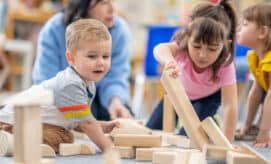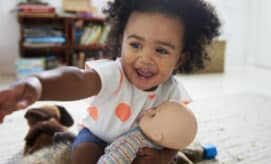Many educators and caregivers use routines and rituals in their classrooms to support young children’s social and emotional development. From morning meetings to transition songs, routines and rituals contribute to an early learning environment in which children feel safe and comfortable to explore and try new things. These feelings of security and stability are particularly important for infant and toddler learning.
Routines and Rituals for Learning
According to ZERO TO THREE, “routines provide the two key ingredients necessary for learning: relationships and repetition.” Routines create a sense of predictability with young children. They help children to know what to expect and what will happen next, which allows them to feel safe and secure. ZERO TO THREE shares that routines and rituals contribute to early learning and development in the following ways:
-
Routines guide positive behavior and safety. Routines such as washing hands before meals or putting on a helmet before riding a bike can help children learn about taking care of themselves and keeping themselves safe. These routines will guide children’s behavior as they get older, and help to set them up for success in elementary school and beyond.
-
Routines support children as they develop social skills. Young children learn a lot about social interactions from their early experiences. Routines and rituals such as saying hello and goodbye help children to learn about how to interact with others, paving the way for them to form friendships and relationships as they get older.
-
Routines help children cope with transitions. One of the most common ways that routines and rituals are used in early learning classrooms is as a support for children during the transitions that take place throughout the day. When a routine or ritual is incorporated into the transition, it can help to reduce some of the fear that children may feel as they move from one activity to the next. Some teachers use songs to indicate that it’s time to clean up and move to the next activity, while others might use a bell or special sound. All of these routines can help children to feel more comfortable, as they learn what to expect throughout the day.
-
Routines are an important opportunity for learning. Through routines and rituals, children learn important life skills that will help them as they grow older and prepare for kindergarten. Rituals also help children to feel safe enough to take risks, experiment with new activities, and challenge themselves.
The Center on the Social and Emotional Foundations of Early Learning (CSEFEL) emphasizes that for infants and early toddlers, it is important for routines to be sequenced in a consistent daily pattern. CSEFEL explains that “with infants and toddlers, the time is not really the issue, but rather the sequence or order for the routines of care. It is more important for the very young child that we engage in the major care activities in a regular order than it is that we try to keep to a time schedule…while for very young infants individualization is the name of the game, older infants and toddlers benefit from flexible routines and schedules.”
Rituals and Routines Created with Children
Educators can invite children and families to contribute to rituals. For example, children might have favorite songs or books that become part of the classroom routine, while saying hello, goodbye or thank you in more than one language is an opportunity to honor the diversity in your classroom.
Early childhood specialist and educational consultant, Carrie Becker, highlights how rituals and routines can be particularly powerful for building relationships and strengthening the bond between children and caregivers: “When we follow a child’s lead we often stumble upon routines and rituals we didn’t anticipate. These co-created rituals and routines build the strongest classroom bonds.”
Rituals and Routines at School and at Home
Educators typically have several rituals built into their classroom flow of the day. If you are looking for more ideas, the list below might help you to find new ways to build routines into your curriculum. The list includes suggestions you can share with parents and families to incorporate into their day, such as at pick-up or drop-off.
Rituals for Educators
Singing a song every morning during circle time, during transitions, clean-up time, or to get ready for naps is a helpful way to remind children what to expect throughout the day.
Nap time can be particularly challenging for toddlers as they wind down from a stimulating day of play and transition to rest. Reading a peaceful book, dimming the lights, and playing a relaxing song are all helpful and supportive rituals to get children ready for a nap.
Rituals for Families
At the end of the day, families might sing a song with their children on their drive home or while they’re having dinner. In a webinar with Tinkergarten, Suzanne Tucker, founder of Generation Mindful shared a fun song to reflect on feelings: “When did I feel happy? When did I feel sad? When did I feel calm? When did I feel mad?” Singing this song at the end of every day is a great ritual for families to use to reflect on feelings and help children start to develop their emotional vocabulary. This song can also be used in the classroom at the end of the day before parent pick-up to give children an opportunity to reflect in a group setting.
The Center on the Social and Emotional Foundations of Early Learning (CSEFEL) encourages educators to “talk to families about having a fun ‘goodbye’ ritual that they can do everyday with their child. For example, mom might help her son hang up his backpack and then give good-bye butterfly kisses while saying, ‘Here’s my special butterfly kiss to last throughout the day, I’ll be back to pick you up, so go and play!’”





